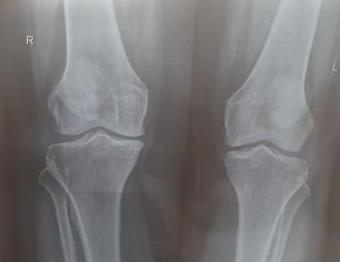Knee osteoarthritis (OA)
Knee osteoarthritis (OA) is a common degenerative joint disease that affects the knee joint. It is characterized by the breakdown of the cartilage in the knee joint, leading to pain, stiffness, and decreased mobility. Knee OA is a leading cause of disability and can significantly impact a person’s quality of life.
In this article, we will discuss the causes, symptoms, diagnosis, and treatment options for knee osteoarthritis. We will also explore the risk factors for developing knee OA and the impact it can have on a person’s daily life.

Causes of Knee Osteoarthritis
Knee osteoarthritis is caused by a combination of factors, including age, genetics, and joint injury. As people age, the cartilage in their joints can begin to break down, leading to the development of OA. Genetics also play a role in the development of knee OA, as some people may be more predisposed to the condition due to their family history. Additionally, joint injuries, such as a torn meniscus or ligament damage, can increase the risk of developing knee OA later in life.
Symptoms of Knee Osteoarthritis
The symptoms of knee osteoarthritis can vary from person to person, but common symptoms include pain, stiffness, and swelling in the knee joint. People with knee OA may also experience a decreased range of motion in the affected knee, making it difficult to bend or straighten the knee fully. As the condition progresses, people with knee OA may also experience a grating sensation in the knee joint, as well as the development of bone spurs around the joint.
Diagnosis of Knee Osteoarthritis
Diagnosing knee osteoarthritis typically involves a physical examination, as well as imaging tests such as X-rays or MRI scans. During the physical examination, a healthcare provider will assess the range of motion in the affected knee, as well as look for signs of swelling or tenderness. Imaging tests can help to confirm the diagnosis of knee OA by showing the extent of cartilage loss, as well as any bone spurs or other joint changes.
Treatment Options for Knee Osteoarthritis
There are several treatment options available for knee osteoarthritis, ranging from conservative measures such as lifestyle modifications and physical therapy to more invasive treatments such as joint injections or surgery. Conservative treatments for knee OA may include weight management, exercise, and the use of assistive devices such as knee braces or canes. Physical therapy can also be beneficial for people with knee OA, as it can help to improve joint flexibility and strengthen the muscles around the knee joint.
In some cases, healthcare providers may recommend the use of nonsteroidal anti-inflammatory drugs (NSAIDs) or corticosteroid injections to help manage the pain and inflammation associated with knee OA. These medications can provide temporary relief from symptoms, but they do not address the underlying cause of the condition.
For people with more severe knee osteoarthritis, joint replacement surgery may be necessary to restore function and reduce pain in the affected knee. During a knee replacement surgery, the damaged parts of the knee joint are removed and replaced with artificial components, such as metal and plastic implants. This can help to improve mobility and reduce pain in the affected knee, allowing people to return to their normal activities.
Impact of Knee Osteoarthritis on Daily Life
Knee osteoarthritis can have a significant impact on a person’s daily life, affecting their ability to perform simple tasks such as walking, climbing stairs, or getting in and out of a chair. People with knee OA may also experience difficulty with activities that require bending or kneeling, such as gardening or playing with children or grandchildren. The pain and stiffness associated with knee OA can also lead to decreased physical activity, which can contribute to weight gain and a decline in overall health.
In addition to the physical limitations caused by knee osteoarthritis, the condition can also have a negative impact on a person’s mental and emotional well-being. Chronic pain and limited mobility can lead to feelings of frustration, anxiety, and depression, as people struggle to cope with the changes in their daily life. This can also impact their relationships with family and friends, as well as their ability to participate in social activities and hobbies that they once enjoyed.
Prevention of Knee Osteoarthritis
While some risk factors for knee osteoarthritis, such as age and genetics, cannot be changed, there are steps that people can take to reduce their risk of developing the condition. Maintaining a healthy weight and staying physically active can help to reduce the strain on the knee joints, as well as improve overall joint health. Engaging in regular exercise, such as walking, swimming, or cycling, can also help to strengthen the muscles around the knee joint and improve joint flexibility.
In addition to regular exercise, people can also protect their knee joints by using proper body mechanics and avoiding activities that put excessive strain on the knees. This may include using supportive footwear, taking breaks during prolonged periods of standing or sitting, and using assistive devices such as knee braces or canes when necessary. People with a history of joint injuries should also take steps to protect their knee joints from further damage, such as wearing proper protective gear during sports or other physical activities.
Conclusion
Knee osteoarthritis is a common degenerative joint disease that can have a significant impact on a person’s daily life. It is caused by the breakdown of the cartilage in the knee joint, leading to pain, stiffness, and decreased mobility. While there is no cure for knee OA, there are several treatment options available to help manage the symptoms and improve the quality of life for people with the condition. By taking steps to protect their knee joints and maintain a healthy lifestyle, people can reduce their risk of developing knee osteoarthritis and improve their overall joint health.
